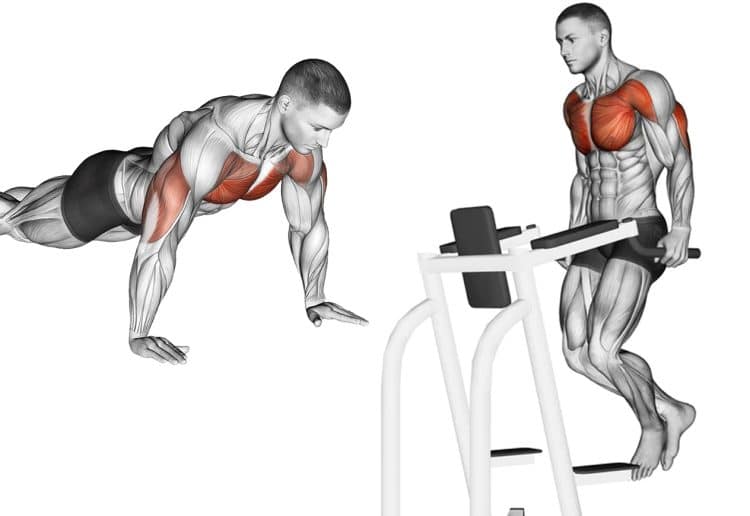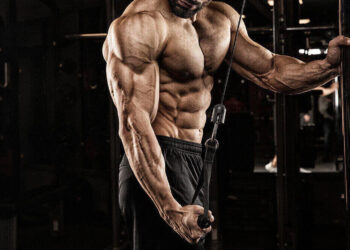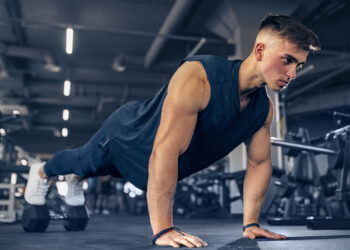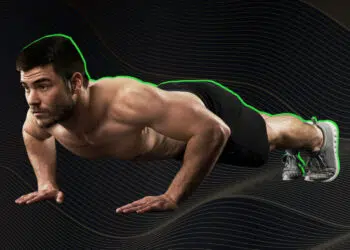According to popular opinion, the bench press is the best chest exercise. It’s undoubtedly the most popular. Consequently, most bodybuilders do bench presses to pump up their pecs, and powerlifters use this exercise to develop and test their strength.
However, as a personal trainer and former powerlifter with over three decades of experience, I’ve also seen the dark side of the bench press.
For starters, some people are bench press non-responders. By that, I mean they get very little chest growth from this exercise. In addition, some lifters find that the bench press causes joint pain. I’ve also seen (but thankfully never experienced) plenty of pec tears during bench presses.
And, of course, you need access to a bench and barbell to do this exercise, which may be an issue for some people. So, while plenty of people make great gains with bench pressing, others do not.
The good news is that you don’t need to do bench presses to build a strong, muscular upper body. In fact, you don’t even need any weights.
Push-ups and dips work the same muscles as bench presses (1) and are often more accessible. I’m a big fan of both these exercises and often use them in place of bench presses, both in my own workouts and those of my clients.
Level Up Your Fitness: Join our 💪 strong community in Fitness Volt Newsletter. Get daily inspiration, expert-backed workouts, nutrition tips, the latest in strength sports, and the support you need to reach your goals. Subscribe for free!
But which should you do – push-ups or dips? In this article, I compare and contrast these exercises so you can pick the best one for your needs and goals.
How to Do Push-Ups
While push-ups are probably the most widely performed exercise on the planet, I’m always surprised how few people perform them correctly. In fact, poor push-up form is becoming increasingly common. Needless to say, if you want to get the best from push-ups while keeping your risk of injury to a minimum, your form matters.
With that in mind, follow these step-by-step instructions to make sure that your pull-up performance is perfect.
- Kneel down and place your hands flat on the floor, shoulder-width apart. Your fingers should be pointing forward.
- Pull your shoulders down and back, and brace your core.
- Walk your feet out so your body and legs are straight.
- Turn your elbows into your sides to stabilize your shoulders and upper back.
- Bend your arms and lower your chest to within an inch of the floor.
- Extend your arms and repeat.
Tips:
- Bend your legs and rest on your knees to make push-ups easier.
- Put your feet on a bench or chair to make push-ups more challenging.
- Increase your range of movement by placing your hands on blocks or using push-up handles.
- Wear a weighted vest to make push-ups more intense.
- Move your hands closer together to work your triceps more. Spread your hands further apart to increase chest/shoulder engagement.
Check the complete push-up guide here.
How to Do Dips
Dips are a popular upper-body exercise, although they’re not as common as push-ups. That’s probably because they’re a) harder and b) you need some equipment to do them correctly.
I’m specifically talking about parallel bar dips and not bench dips, which do not compare favorably to push-ups.
Dips are a little harder on your shoulders than push-ups, so follow these instructions to maximize your gains while minimizing the risk of injury.
- Grip the bars with your palms facing inward. Push your shoulders down and back and brace your core.
- Extend your arms so your feet are clear of the floor. Bend your legs if necessary.
- Leaning forward slightly as you descend, bend your elbows until your upper arms are at least parallel to the floor.
- Push yourself back up to the starting position and repeat.
Tips:
- Use a resistance band for assistance to make dips easier.
- Narrow hand placement increases triceps engagement, while wider hands work your chest more.
- Use a weighted vest or weighted dipping belt to make this exercise harder.
- Lean forward and flare your elbows to increase chest engagement.
- Rest your feet on a bench or step behind you to make this exercise a little easier.
Check the complete dips guide here.
Push-Ups Vs. Dips – Muscles Worked
Push-ups and dips are compound exercises. This means they involve multiple muscles and joints all working together. Both exercises work all your major upper body pushing muscles. In fact, push-ups and dips work the SAME muscles.
These muscles are:
- Pectoralis major – push-ups and dips are a great way to build and strengthen your pectoralis major or pecs. This is your primary chest muscle. Because of the angle of your arms, both exercises emphasize your lower pecs. However, the rest of your chest also gets a good workout.
- Deltoids – the delts are your main shoulder muscles. There are three sets of deltoid fibers or heads: anterior (front), medial (middle/side), and posterior (rear). All three heads are active during push-ups and dips. Still, the anterior deltoids are working hardest, while the medial and posterior fibers are mostly working as stabilizers.
- Triceps brachii – located on the back of your upper arms, the triceps are your primary elbow extensors. Because of their relatively smaller size, the triceps tend to fail before the more prominent pecs during push-ups and dips.
- Core – while push-ups and dips primarily work your chest, shoulders, and triceps, your core is strongly involved, too. The core is the collective term for the muscles of your midsection, including the rectus abdominis, obliques, and transverse abdominis. These muscles contract to stabilize your lumbar spine, preventing unwanted movement of your lower back.

Push-Ups Vs. Dips – Muscles Recruitment
While push-ups and dips involve the same muscles, each exercise uses those muscles slightly differently.
According to research by the American Council on Exercise (ACE), dips involve more chest recruitment than push-ups (2). This makes a certain amount of sense, given that dips involve a larger range of motion at the shoulder joint, which is directly controlled by the pecs. Based on ACE’s findings, dips rank as the sixth-best chest exercise.
In contrast, according to another ACE study, push-ups work the triceps more than dips (3). However, it’s important to note that the researchers were comparing dips with diamond push-ups and not the conventional version. Diamond push-ups were rated as the best all-around triceps exercise, while dips came in at number three.
The bottom line is that both push-ups and dips work your chest and triceps pretty equally. However, dips probably hit your pecs harder, while push-ups are slightly more triceps dominant.
That said, it’s worth noting that this is a very small body of evidence, and the results may not hold true for everyone. After all, plenty of bodybuilders have built huge triceps with dips, and there are numerous calisthenic athletes with great-looking chests from push-ups.
Level Up Your Fitness: Join our 💪 strong community in Fitness Volt Newsletter. Get daily inspiration, expert-backed workouts, nutrition tips, the latest in strength sports, and the support you need to reach your goals. Subscribe for free!
Push-Ups vs. Dips – Comparison
While push-ups and dips look different, they work the same muscles, and both can help you build a sculpted chest and stronger triceps. As such, they’re somewhat interchangeable. However, because of their differences, one exercise may be better than the other.
Weigh up the following considerations to decide whether push-ups or dips are right for you.
Accessibility
Push-ups and dips are calisthenic or bodyweight exercises. As such, you don’t need weights to do them. However, you’ll need a set of parallel bars to do dips, whereas push-ups require no additional equipment.
As such, push-ups are the ultimate excuse-free chest and triceps exercise, as you can do them anywhere and anytime. Of course, this consideration is irrelevant if you have easy access to parallel bars.
Ease of Learning
Push-ups are often considered to be a beginner exercise. While that isn’t necessarily the case, it does suggest that push-ups are easy to learn. That’s not to say that push-ups are entirely straightforward, and there are a few technical nuances that you must master to make this exercise as safe and effective as possible.
In contrast, dips are technically more difficult. With only two points of contact, you need to know how to stabilize your shoulders and trunk to perform them correctly. The extra load also means that dips are more demanding than push-ups.
Overload
While push-ups and dips are both bodyweight exercises, the amount of weight on your arms is significantly different. For conventional push-ups, the weight on your arms is about 60% of your body weight. In contrast, the weight on your arms during dips is closer to 90%.
However, it’s worth noting that these percentages are approximate, and things like body composition and technique will affect the actual weight on your arms. That said, dips overload your arms more than push-ups. As such, dips are potentially the better strength builder. Conversely, most people can do more push-ups than dips.
Range of Motion
One of the reasons that dips are potentially better than push-ups for chest development is their larger range of motion. Dips start with your arms extended and then descend into a deep chest stretch. Studies show that deep, weighted stretches can contribute to muscle growth (4).
In contrast, you can only descend as far as the floor with conventional push-ups. However, using push-up handles means you can stretch down a little deeper, negating this minor drawback.
Variations
Push-ups and dips are classic calisthenic exercises, and you can get great results from both of these two well-known exercises. However, doing the same variations over and over may eventually become boring, and your progress could stall.
The good news is that there are several push-up and dip variations you can use to keep your workouts productive and enjoyable. For example, you can do ring, close, wide, straight bar, and bench dips instead of the conventional parallel bar dip.
However, in terms of variety, push-ups are hard to beat as there are dozens of different push-up exercises to choose from. These include incline, decline, deficit, single-arm, archer, ring, diamond, plyometric, wide, knuckles, and many, MANY others.
So, if you want an exercise that will never become boring, push-ups are the clear winner.
Related: 15 Intense Push-Up Variations for Bodybuilders
Safety
With no heavy weights to drop or get pinned under, push-ups and dips are pretty safe exercises. You can train to complete failure alone without a spotter and very little risk of injury.
However, the large range of motion and angle of your torso during dips puts a lot of stress on the shoulder joints. As such, dips can cause acute and chronic shoulder pain. Consequently, some exercisers may be better off doing push-ups rather than dips.
Push-Ups Vs. Dips – Closing Thoughts
Despite looking very different, push-ups and dips work the same muscles, namely your chest, shoulders, and triceps. By virtue of their larger range of motion, dips are slightly more pec-centric than push-ups, but the differences are marginal. In fact, the main difference between push-ups and dips is the amount of weight on your arms.
So, which one should you do?
Personally, I like push-ups and dips equally and include both of these exercises in my upper-body workouts. However, if you have to choose between these two similarly effective movements, pick the one that suits you best.
For example, if you suffer from persistent shoulder pain, push-ups are probably a better match than dips. On the flip side, dips are the way to go if you are already pretty strong and want to overload your muscles more.
Of course, you don’t have to choose between these exercises, and you’ll probably make even better gains by combining them into the same workout or schedule. Whichever one you do, perform it with perfect form, and you’ll get the best possible results with the lowest risk of injury.
References:
- Comparison of Kinematics and Muscle Activation between Push-up and Bench Press. Sports Med Int Open. Tillaar RVD. 2019 Sep 5;3(3):E74-E81. doi: 10.1055/a-1001-2526. PMID: 31508485; PMCID: PMC6728153.
- American Council on Exercise: Top 3 Most Effective Chest Exercises.
- American Council on Exercise: Best Triceps Exercises.
- Physiology of Stretch-Mediated Hypertrophy and Strength Increases: A Narrative Review. Sports Med. Warneke K, Lohmann LH, Lima CD, Hollander K, Konrad A, Zech A, Nakamura M, Wirth K, Keiner M, Behm DG. 2023 Nov;53(11):2055-2075. doi: 10.1007/s40279-023-01898-x. Epub 2023 Aug 9. PMID: 37556026; PMCID: PMC10587333.
Article Updates Timeline:
Our editorial team experts constantly update the articles with new information & research, ensuring you always have access to the latest and most reliable information.
January 21, 2024
Written By
Patrick Dale, PT, ex-Marine
Updated By
Editorial Team
Reviewed By
Tom Miller, CSCS
Interested in measuring your progress? Check out our strength standards for Bench Press, Push Ups, Bench Dips, and more.








